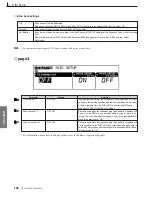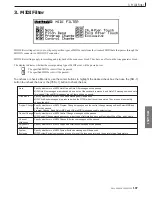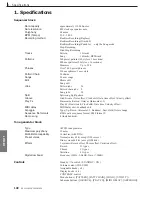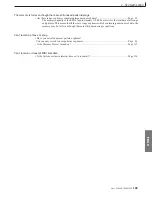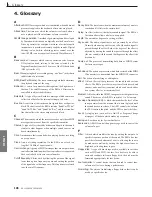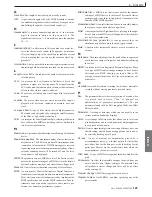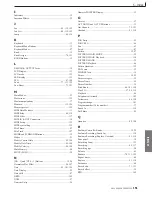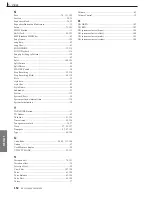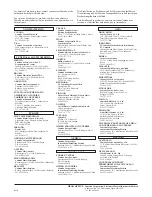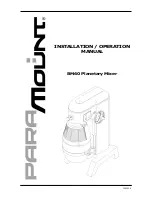
148
RM1x SEQUENCE REMIXER
APPENDIX
Punch in recording:
A method of realtime recording in which the
uses specifies the punch-in and punch-out points, so that re-
cording takes place only in that area.
Q
Quantize:
A function which “tightens up” the inexact timing of notes
or other events that were entered in realtime.
R
Realtime recording:
A method of recording in which your
performance is recorded just as you play, similar to a
conventional multi-track recorder. Since the performance is
recorded as you play, the musical expression and nuances of
your performance will be accurately recorded.
Release time:
The time over which the volume falls from the sustain
level (beginning at the moment a note is released) until it
reaches silence.
Replace:
A method of realtime recording or punch recording in which
previously recorded data is erased (replaced) as new material
is recorded.
Resonance:
A parameter that boosts the level of the signal in the
area of the cutoff frequency. By emphasizing the overtones
in this area, this can produce a distinctive “peaky” tone,
making the sound brighter and harder.
Reverb:
An effect that simulates the acoustical reverberance of a
room or space. The sound that reaches our ear usually includes
not only the direct sound, but also sound that was reflected
off the walls or ceiling. Reverb creates these indirect
reflections artificially. Although some reflections can be
perceived individually as distinct echoes, the term “reverb”
usually refers only to the indistinct “wash” of reflected sound.
RPN:
An acronym for Registered Parameter Number. These MIDI
messages are used to set Part settings such as Pitch Bend
Sensitivity or Tuning.
S
Save:
The process of saving data or songs from internal memory to
floppy disk.
Section:
A term referring to each of the 16 types of patterns that
comprise a style. Patterns are selected by specifying the style
and the section.
Send level:
The amount of signal that is sent to a specified bus line
for processing by an effect. The amount of signal that is
returned from the effect is the “return level.”
Sensitivity:
The degree to which an aspect of the sound (e.g., volume)
responds to a control (e.g., note velocity).
Sequencer:
A block (or device) that records, edits, modifies, and
plays back a musical performance in the form of MIDI mes-
sages.
Sequence tracks:
Tracks which record and playback normal MIDI
sequence data.
SMF:
See the entry for Standard MIDI File.
Song:
A musical composition created by recording performance
data on one or more tracks.
Standard MIDI File (SMF):
SMF is an acronym for Standard MIDI
File; a format that allows easy exchange of song data be-
tween different sequencers. Most of today’s software and
hardware manufacturers provide software/hardware that can
read and write Standard MIDI Files.
Step recording:
The method of recording in which music is input
by entering notes once by one, specifying the note length,
velocity, and pitch etc. of each note.
Stereo location:
The location within the stereo field from which a
sound is heard. This can be modified by the Pan setting.
Style:
The collective name for a set of 16 sections (A-P). Sections
are put together to create a backing pattern.
Synchronization:
The function or process of matching the playback
or recording tempo of a device with a separate, external device
such as another sequencer or a rhythm machine.
Sync:
See Synchronization.
System (effect):
An effect which can be applied to all parts by
adjusting the Send Levels and Return Level. System effects
allow reverb or chorus etc. to be applied to the overall music.
The RM1x provides Reverb and Chorus as system effects.
The Variation effect can also be used as a system effect.
System exclusive message:
A type of MIDI message used to
exchange data unique to a specific model or type of device.
T
Track:
A location where musical performance data is recorded.
Transpose:
Shifting the pitch in semitone steps.
Tremolo:
An effect produced by cyclically modulating the volume.
Tuning:
The process of matching the pitch of two or more instruments
when playing in an ensemble. Normally, A3 is tuned to 440
Hz.
U
Utility mode:
A mode on the RM1x in which system or MIDI settings
can be made.
V
Variation effect:
One of the RM1X’s effects. In Voice submode, this
effect can be used aggressively as a major component of a
sound. The Variation effect can function either as an inser-
tion effect or as a system effect, and provides a wide variety
of effect programs such as delay, rotary speaker, auto pan,
amp simulation and auto wah in addition to reverb and cho-
rus.
Velocity:
A numerical value indicating the speed (force) with which
a note was played.
Vibrato:
A performance effect produced by cyclically modifying the
pitch.
Voice:
A sound that is built into the tone generator that can be se-
lected and played.
Volume:
A parameter or control that adjusts the volume. Track Vol-
ume adjusts the volume of each track, and Master Volume
adjusts the overall volume.
W
Wah effect:
An effect that cyclically modulates the tone. The RM1x
produces this effect by using an LFO signal to modulate the
cutoff frequency of the filter.
4. Glossary



